Introduction to CNC Milling Machines
CNC milling machines represent a significant advancement in machining technology, providing enhanced precision and efficiency compared to traditional milling methods. CNC stands for Computer Numerical Control, a process that automates the control of machining tools through the use of computer programs. This technology allows operators to create complex parts with high accuracy, making it a staple in various industries, including aerospace, automotive, and manufacturing.
Unlike traditional milling machines, which require manual adjustments and skilled personnel for operation, CNC milling machines rely on programmed instructions to dictate the movements of cutting tools. This automation not only reduces the potential for human error but also increases the speed of production. CNC machines can produce parts consistently, ensuring uniformity and compliance with specified tolerances, which is crucial in quality-sensitive industries.
The fundamental principle of CNC technology involves converting a computer-aided design (CAD) into a precise CNC code, which instructs the machine on how to execute specific movements. This process allows for intricate designs that would be impossible or prohibitively time-consuming to achieve using manual methods. Moreover, CNC milling machine operations can be easily adjusted or modified by simply changing the program, offering unparalleled flexibility for manufacturers.
In summary, CNC milling machines have revolutionized the manufacturing process by combining advanced technology with traditional machining principles. Their ability to produce high-quality components quickly and accurately sets them apart from their manual counterparts, making them essential in today’s competitive production environment. Understanding the fundamental aspects of these machines is crucial for individuals exploring careers in engineering, fabrication, or manufacturing technology.
How CNC Milling Machines Work
CNC milling machines operate by utilizing a computer numerical control (CNC) system that automates the machining process, allowing for precise and efficient manufacturing of complex parts. At the core of this technology lies programmed software that interprets design specifications and translates them into a sequence of motions for the machine to execute. This software can often accommodate various file formats, making it versatile for different design applications.
The primary components of a CNC milling machine include a computer, control unit, motors, spindles, and cutting tools. The computer serves as the brain of the operation, where the desired part design is loaded into the CNC software. This design, usually created with a Computer-Aided Design (CAD) program, is transformed into a set of instructions in a format known as G-code, which dictates the movements required by the machine.
Motors play a crucial role in driving the machine’s axes—typically, a CNC milling machine operates on three to five axes, allowing it to move in various directions. The positioning of the cutting tool is manipulated by the movement of these axes, facilitating the precision required for intricate designs. Additionally, spindles are responsible for rotating the cutting tools at high speeds, ensuring efficient material removal while maintaining the desired finish quality.
The cutting tools themselves come in various shapes and sizes, tailored to the specific material being machined and the complexity of the cuts required. These tools are often made from durable materials such as carbide or high-speed steel, ensuring longevity and stability during operation. As the automated processes proceed, the CNC milling machine continuously monitors and adjusts its operations in real time, enhancing accuracy and reducing the likelihood of errors.
The automation of the CNC milling process not only streamlines production but also significantly reduces manual labor costs, while increasing the overall quality and consistency of the final products. Understanding these mechanisms is essential for those looking to innovate or enhance their manufacturing capabilities.
Types of CNC Milling Machines
CNC milling machines can be categorized into several types, each designed to serve specific functions and applications in the manufacturing industry. One of the most common types is the vertical milling machine, which features a vertically oriented spindle. This design allows for precise operations on flat surfaces, grooves, and intricate shapes. Vertical milling machines are frequently utilized for applications such as drilling, boring, and contouring, making them a popular choice for small to medium-sized manufacturing setups.
In contrast, horizontal milling machines employ a horizontally placed spindle to facilitate the milling process. This configuration enhances the machine’s ability to handle larger and heavier workpieces. Horizontal machines are particularly effective for operations that require multiple cuts in a single setup, such as the production of complex components with several dimensions. Their robust design contributes to improved stability and accuracy, making them ideal for industries like aerospace and automotive manufacturing.
Another notable type of CNC milling machine is the 5-axis machine, which allows for machining operations along five different axes simultaneously. This capability enables the creation of intricate parts with complex geometries that would be challenging to achieve with traditional milling machines. As a result, 5-axis CNC milling machines are extensively used in sectors that demand high precision and efficiency, such as medical device manufacturing and mold making.
Moreover, multi-tasking machines combine milling and turning functions, offering versatility in machining operations. These machines are particularly beneficial in environments where space is limited, as they eliminate the need for multiple machines for different processes. Overall, understanding the various types of CNC milling machines is essential for selecting the right equipment for specific manufacturing needs, thus optimizing production efficiency and quality.
Applications of CNC Milling

CNC milling machines are integral to numerous industries due to their precision and versatility. One of the most prominent sectors utilizing CNC milling technology is aerospace. In this industry, components such as turbine blades, engine housings, and landing gear parts are routinely manufactured using CNC milling to meet stringent specifications. The ability to produce lightweight yet robust components is vital in aerospace engineering, where performance and safety are of utmost importance.
Another significant domain leveraging CNC milling is the automotive industry. The manufacture of intricate parts such as engine blocks, transmission housings, and vehicle body panels is greatly enhanced by utilizing CNC milling machines. These machines provide the necessary accuracy and repeatability, allowing automotive manufacturers to produce parts that fit precisely and function optimally. The efficiency and scalability of CNC milling also contribute to accelerating production timelines and reducing costs.
Furthermore, the medical industry increasingly turns to CNC milling for the production of complex surgical instruments and implants. Components like dental crowns, prosthetic limbs, and orthopedic devices are crafted with exceptional precision. The customization capabilities provided by CNC milling enable healthcare professionals to obtain products tailored to individual patient requirements, thus enhancing patient outcomes significantly.
Lastly, the electronics industry frequently relies on CNC milling for the fabrication of circuit boards, enclosures, and connectors. The ability to create intricate patterns and fine features with high levels of accuracy makes CNC milling a preferred method in this field. As technology continues to advance, the application of CNC milling will further expand, driving innovation across multiple sectors while maintaining stringent quality standards.
Benefits of Using CNC Milling Machines
CNC milling machines have revolutionized manufacturing by offering numerous advantages over traditional machining processes. One of the most significant benefits is precision. CNC, which stands for Computer Numerical Control, enables the machinery to operate with high accuracy. Unlike manual machines, where human error can impact the final product, CNC machines are programmed to execute exact measurements and complex geometries. This level of precision is essential in various industries, including aerospace, automotive, and medical. The use of CNC technology ensures that components meet stringent specifications consistently.
Efficiency is another compelling benefit of CNC milling machines. These machines can operate for extended periods with minimal human intervention, leading to faster production rates and reduced labor costs. The automation of processes means that manufacturers can produce a higher volume of products in less time, translating to increased throughput. Moreover, as CNC milling machines can quickly switch between different tasks or components, they offer remarkable flexibility, allowing manufacturers to adapt to changing demands or specifications with ease.
Flexibility and repeatability are closely related advantages of CNC milling technology. Unlike conventional methods, which may require recalibration for each new batch, CNC machines can reproduce identical or highly similar components consistently. This repeatability is crucial for industries where uniformity is necessary, such as electronics and mechanical assemblies. Since the same CNC program can be used for multiple runs, manufacturers can ensure quality control across production batches, reducing waste and increasing profitability.
Overall, the integration of CNC milling machines into manufacturing workflows not only enhances precision and efficiency but also offers unparalleled flexibility and repeatability, contributing to improved production processes and ultimately elevating the quality of the final products. As industries continue to evolve, the importance of adopting such advanced technologies cannot be overstated.
Common CNC Milling Techniques
CNC milling machines are versatile tools that employ various techniques to create precise and uniform components across a range of industries. Among the prevalent CNC milling techniques, slotting, drilling, and contouring stand out due to their broad applicability in manufacturing processes.
Slotting is a technique where a specific notch or slot is cut into a workpiece. This process is essential for creating keyways, grooves, or channels that facilitate the assembly of machinery parts. In industries like automotive and aerospace, slotting is crucial for ensuring that parts fit together correctly, enhancing functionality and performance.
Drilling is another fundamental technique utilized in CNC milling. This method involves creating round holes in a workpiece, which can be used for fasteners or as part of a larger assembly. Drill bits can be customized for various sizes and geometries, making this technique highly adaptable. Drilling is widely used in the construction, electronics, and furniture manufacturing industries, where precise holes are required to attach components or for aesthetic purposes.
Contouring, on the other hand, refers to the machining of curved and intricate shapes along the surface of a workpiece. This technique is particularly valuable in industries such as medical device manufacturing and consumer product design, where the aesthetics and ergonomics of a product are critical. Contouring allows for the creation of complex shapes that would be difficult to achieve using traditional machining methods.
Each of these techniques—slotting, drilling, and contouring—illustrates the capabilities of CNC milling machines. By utilizing computer numerical control, these techniques provide enhanced precision, efficiency, and versatility, making them indispensable in modern manufacturing. Continuous advancements in these methods further enhance their applicability across various industries, ensuring optimal production processes.
Maintenance and Care for CNC Milling Machines
Ensuring the optimal performance and longevity of CNC milling machines requires a systematic approach to maintenance and care. Regular inspections are fundamental in identifying potential issues before they escalate into costly repairs. Operators should develop a maintenance schedule that includes daily, weekly, and monthly checks to assess various components such as the spindle, feed mechanism, and coolant systems. These inspections should include checks for wear and tear, looseness in parts, and signs of overheating.
Cleaning is another crucial aspect of CNC milling machine maintenance. Chips, dust, and other particles can accumulate during operation, affecting the machine’s precision and performance. It is essential to clean the work area, tool holders, and the machine itself regularly. Using appropriate cleaning solutions and tools can ensure that contaminants do not accumulate. It is also advisable to remove any debris from cooling systems to maintain proper thermal management.
Lubrication is equally important for preserving CNC milling machines. Properly lubricated components will experience less friction, resulting in reduced wear and longer service intervals. Operators should consult the manufacturer’s manual for guidance on the correct type of lubricant and the appropriate intervals for application. Regular lubrication not only extends the life of the machine but also improves its accuracy and operational efficiency.
Lastly, software updates are often overlooked but are vital for maintaining the performance of CNC milling machines. Operating systems and machine controls may periodically receive updates to enhance their functionality and fix known bugs. Keeping software up to date ensures that the machines operate at peak efficiency and can incorporate the latest technological advancements. Adopting these maintenance procedures will contribute significantly to maximizing the lifespan and performance of CNC milling machines.
Future Trends in CNC Milling Technology
The landscape of CNC milling technology is undergoing significant transformation, driven primarily by advancements in automation, artificial intelligence (AI), and the development of improved materials. These trends are reshaping the manufacturing sector, leading to enhanced efficiency and capabilities in various industries.
One major trend is the integration of automation in CNC milling processes. This development allows for reduced human intervention, enabling machines to operate continuously and perform more complex tasks with greater precision. As automation becomes more prevalent, manufacturers are experiencing shorter production cycles and lower operational costs. Additionally, the implementation of collaborative robots, or “cobots,” in CNC milling operations is increasingly common. These robots work alongside human operators, assisting in repetitive or physically demanding tasks, thereby improving overall productivity and reducing strain on workers.
Artificial intelligence is another pivotal element influencing the future of CNC milling technology. The incorporation of AI algorithms allows for predictive maintenance, which anticipates equipment failures before they occur, thus minimizing downtime and repair costs. Furthermore, AI-driven systems are enhancing the machining process itself, optimizing cutting parameters based on real-time data analysis. This leads to improved machining quality and extended tool life, which are critical factors in a competitive manufacturing environment.
Lastly, the development of advanced materials is transforming CNC milling capabilities. Innovations such as composite materials and high-performance alloys are enabling manufacturers to create more durable and lightweight products. These materials not only enhance the performance of finished goods but also expand the scope of applications for CNC milling technologies across various sectors, including aerospace, automotive, and healthcare.
As these trends continue to evolve, the CNC milling industry stands poised to experience a significant shift towards greater efficiency and innovation, ultimately positioning manufacturers to better meet market demands and challenges.
Conclusion
CNC milling machines represent a pivotal advancement in manufacturing technology, significantly enhancing precision, efficiency, and versatility in the production process. Through automated systems and computer numerical control, these machines enable manufacturers to achieve intricate designs that were previously labor-intensive and time-consuming. This guide has explored the fundamental aspects of CNC machining, including its operational mechanics, applications across various industries, and the advantages it offers over traditional milling methods.
One of the key takeaways is the role of CNC milling in streamlining production workflows. As industries continue to prioritize automation and precision, the adoption of CNC technology is vital for maintaining competitive advantage. Moreover, the ability to produce high-quality components with minimal human intervention not only optimizes labor costs but also minimizes the risk of errors associated with manual processes. This leads to increased productivity levels and a reduction in waste, further affirming the importance of CNC milling in modern manufacturing environments.
For those interested in delving deeper into CNC milling and its applications, numerous resources are available online, including technical manuals, video tutorials, and forums comprising experts in the field. These materials can provide additional insights into specific CNC milling techniques, programming skills, and the latest innovations within this technology. Understanding the ongoing developments in CNC machining is crucial for professionals aiming to enhance their expertise and adapt to the ever-evolving landscape of manufacturing.
In conclusion, CNC milling machines are essential tools that shape the future of manufacturing, offering unparalleled precision and efficiency. As industries evolve, embracing such technologies will undoubtedly influence the direction of production methods and outcomes.

